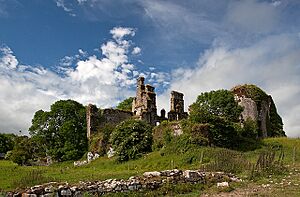James Barry, 4th Earl of Barrymore facts for kids
Quick facts for kids
James Barry, 4th Earl of Barrymore
|
|
|---|---|
 |
|
| Member of Parliament for Stockbridge |
|
| In office 1710–1713 Serving with George Dashwood
|
|
| Preceded by | |
| Succeeded by | |
| Member of Parliament for Stockbridge |
|
| In office 1714–1715 Serving with Thomas Brodrick
|
|
| Preceded by |
|
| Succeeded by |
|
| Member of Parliament for Wigan |
|
| In office 1715–1727 Serving with Sir Roger Bradshaigh
|
|
| Preceded by |
|
| Succeeded by |
|
| Member of Parliament for Wigan |
|
| In office 1734–1747 Serving with
|
|
| Preceded by |
|
| Succeeded by |
|
| Personal details | |
| Born | 1667 |
| Died | 5 January 1748 |
James Barry, 4th Earl of Barrymore (born 1667 – died 5 January 1748) was an important figure in Irish and British history. He was known as a soldier and a politician. He also supported the Jacobite cause, which meant he wanted the old royal family, the Stuarts, to return to the throne.
Contents
Early Life of James Barry
James Barry was the son of Richard Barry, 2nd Earl of Barrymore. His mother was Dorothy Ferrar. James became the 4th Earl of Barrymore on 17 April 1699. This happened after his half-brother, Laurence Barry, passed away.
Military Career and Service
James Barry began his military career during a time of big changes in England. When William of Orange invaded England in 1688, James Barry supported him. This event is known as the Glorious Revolution. Because of his support, he was made a lieutenant-colonel in William's army.
Later, in 1702, the War of the Spanish Succession began. James Barry bought a military regiment, the 13th Regiment of Foot. He became its Colonel. Over the years, he was promoted several times. He became a brigadier-general around 1707. Then, he was made a major-general in 1709. Finally, he reached the rank of lieutenant-general in 1711.
He fought under Lord Galway. He was captured after the Battle of Almansa in 1707. When George I became king in 1715, James Barry had to sell his regiment. This was because George I did not trust some politicians and military leaders.
Political Life and Roles
James Barry was also active in politics. In 1704, he took his place in the Irish House of Lords. This was a part of the Irish Parliament.
In 1710, he was elected as a Tory Member of Parliament (MP). He represented Stockbridge in the British House of Commons. He lost this seat in 1713 but got it back after an appeal.
In 1715, he was elected MP for Wigan. He held this seat for many years, until 1747. There was a short break between 1727 and 1734. In 1714, he was also appointed to the Irish Privy Council. This was a group of advisors to the monarch in Ireland.
Support for the Jacobite Cause
Later in his life, James Barry became a supporter of the Pretender. The Pretender was James Francis Edward Stuart, who believed he should be the rightful king of Britain. This movement was called Jacobitism.
Around 1740, James Barry discussed with other English politicians how to bring the Stuart family back to power. They hoped for help from France. He even visited a French leader, Cardinal Fleury, to ask for support.
In 1743, a French official traveled to London. He met with James Barry and others to talk about a possible French invasion. The group also sent a message to the French king. They asked for help for a combined French and Jacobite invasion. James Barry was planned to be part of a special council if the Stuarts returned to power.
In February 1744, the British government learned about these plans. They found out through a spy in France. James Barry was questioned about his activities. However, after a major Jacobite uprising failed in 1745, the government decided not to pursue charges against him.
Family Life
James Barry was married three times and had several children.
His first wife was Hon. Elizabeth Boyle. They married before 1703. They had two daughters and one son, who sadly passed away as an infant.
- Lady Charlotte Barry
- Lady Anne Barry
His second wife was Lady Elizabeth Savage. They married in June 1706. They had one daughter:
- Lady Penelope Barry
Lady Elizabeth passed away in 1714.
His third wife was Lady Anne Chichester. They married on 12 July 1716 in London. They had four sons and two daughters:
- James Barry, 5th Earl of Barrymore
- Hon. Richard Barry
- Lady Catherine Barry
- Lady Anne Barry
- Hon. Arthur Barry
- Hon. John Smith-Barry


